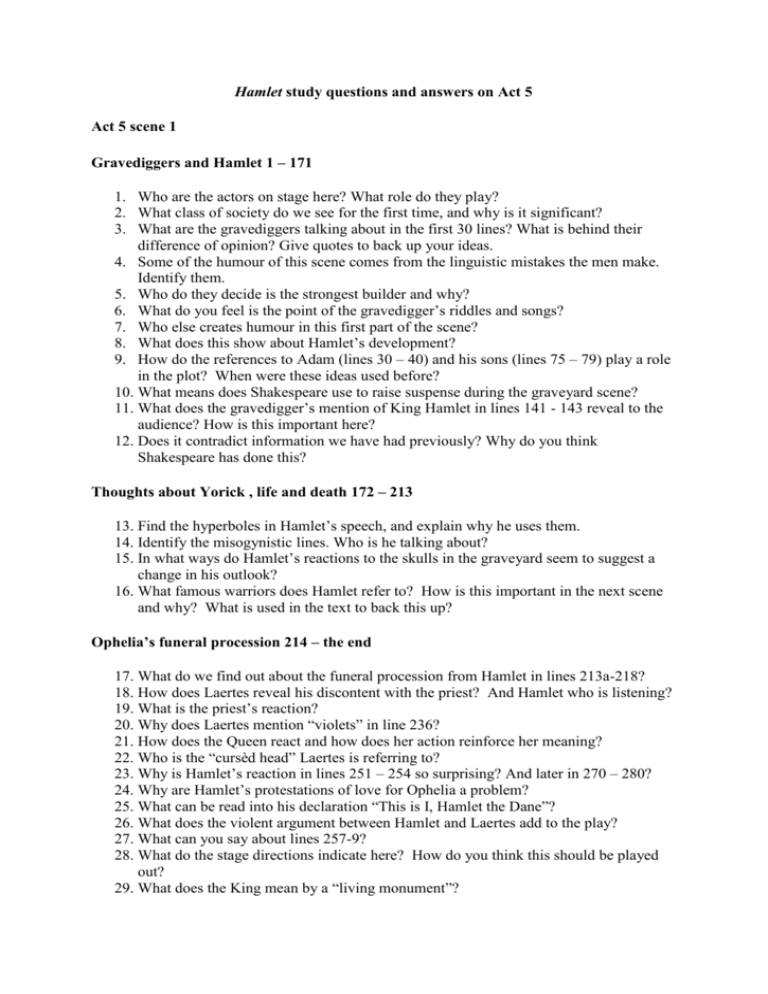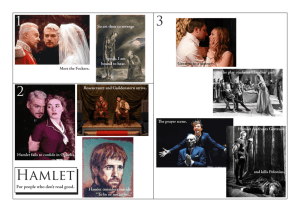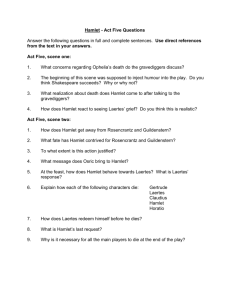Hamlet study questions and answers on Act 5
advertisement

Hamlet study questions and answers on Act 5 Act 5 scene 1 Gravediggers and Hamlet 1 – 171 1. Who are the actors on stage here? What role do they play? 2. What class of society do we see for the first time, and why is it significant? 3. What are the gravediggers talking about in the first 30 lines? What is behind their difference of opinion? Give quotes to back up your ideas. 4. Some of the humour of this scene comes from the linguistic mistakes the men make. Identify them. 5. Who do they decide is the strongest builder and why? 6. What do you feel is the point of the gravedigger’s riddles and songs? 7. Who else creates humour in this first part of the scene? 8. What does this show about Hamlet’s development? 9. How do the references to Adam (lines 30 – 40) and his sons (lines 75 – 79) play a role in the plot? When were these ideas used before? 10. What means does Shakespeare use to raise suspense during the graveyard scene? 11. What does the gravedigger’s mention of King Hamlet in lines 141 - 143 reveal to the audience? How is this important here? 12. Does it contradict information we have had previously? Why do you think Shakespeare has done this? Thoughts about Yorick , life and death 172 – 213 13. Find the hyperboles in Hamlet’s speech, and explain why he uses them. 14. Identify the misogynistic lines. Who is he talking about? 15. In what ways do Hamlet’s reactions to the skulls in the graveyard seem to suggest a change in his outlook? 16. What famous warriors does Hamlet refer to? How is this important in the next scene and why? What is used in the text to back this up? Ophelia’s funeral procession 214 – the end 17. What do we find out about the funeral procession from Hamlet in lines 213a-218? 18. How does Laertes reveal his discontent with the priest? And Hamlet who is listening? 19. What is the priest’s reaction? 20. Why does Laertes mention “violets” in line 236? 21. How does the Queen react and how does her action reinforce her meaning? 22. Who is the “cursèd head” Laertes is referring to? 23. Why is Hamlet’s reaction in lines 251 – 254 so surprising? And later in 270 – 280? 24. Why are Hamlet’s protestations of love for Ophelia a problem? 25. What can be read into his declaration “This is I, Hamlet the Dane”? 26. What does the violent argument between Hamlet and Laertes add to the play? 27. What can you say about lines 257-9? 28. What do the stage directions indicate here? How do you think this should be played out? 29. What does the King mean by a “living monument”? Act 5 scene 2 Hamlet tells Horatio how he turned the tables on Rosencrantz and Guildenstern 1-80 1. What is Hamlet referring to in line one? 2. What developments in H’s character are presented through the story of what happened in the boat? (lines 1 – 62) For example, what does he say about Providence? 3. What does he mean by “the readiness is all”? 4. What does Hamlet punctuate his tale with to get Horatio to respond? Why do you think this is done? 5. What change in Hamlet’s personality do you perceive in his answer ‘lines 57ff) to Horatio’s “So Guildenstern and Rosencrantz go to’t”? 6. How do Hamlet’s motives for killing Claudius seem to have shifted according to his speech in lines 64 – 70? 7. What language does Hamlet use to refer to Claudius? The foppish Osrick 81 – 219 8. How does Osrick provide comic relief here? 9. What does he help reveal about Hamlet? 10. What evidence in the text can you find that he is a vain, upstart? Why does Hamlet find him offensive? 11. What concerns of the play are reinforced in this passage? What other scenes does this mirror and how? 12. Osrick reveals the King’s bet (which you can read about on page 308) and tells Hamlet he must “vouchsafe the answer”. What does this sentence do to transform their private conversation? 13. What is Hamlet’s response? What is the dramatic effect here? 14. After Osrick leaves, Horatio tries to warn Hamlet about the upcoming fight. What is Hamlet’s response? What does he say about Providence? How does this fit his current state of mind? What effect is created? The final fight 220 – 343 15. What does Hamlet admit to in his speech to Laertes? What images does he use? 16. What reason does Hamlet give for his behaviour towards Laertes? 17. Why does Hamlet apologize? How does this reinforce the themes of the play? 18. How does Laertes want to appear in his response? Give quotes to back up your ideas. How does the audience know this is not true? What effect is created? 19. What play on words is used in lines 248 – 250? Why is this ironic? 20. Give evidence that the King’s gesture in lines 261 – 272 is only for show. How is this important? What effect is created through the use of props? 21. How does the stagecraft reinforce the Queen’s newfound loyalty to Hamlet? Give quotes to back this up. 22. When the Queen is poisoned, neither the King nor Laertes try to save her or confess. How is this important? 23. Why does Hamlet need to remain innocent until it is too late? 24. What effect does the word “poison” have on Hamlet? 25. In the end how does Claudius die? What does his death mirror? 26. Why is line 323 so important to the ending of the play? 27. Why does Horatio say he is “more an antique Roman than a Dane”? 340 – the end 28. What do Horatio’s words in lines 353 – 354 reflect? 29. Whose “ears” are being referred to in lines 364 – 365? How is it fitting for this character? 30. What do Horatio’s line sum up from 374 – 379? Do you think this is satisfactory? Why or why not? 31. What type of funeral does Hamlet get in the end and why? Give quotes to back up your answer. 32. What pattern is completed at the end of the play? 33. Is it possible to see Hamlet as having won?








